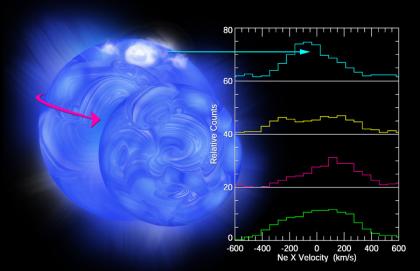November 21, 2001
CXC PR: 01-15
How would our Sun behave differently if it had a closely orbiting twin? While astronomers don't know the exact answer, NASA's Chandra X-ray Observatory has observed an intriguing star system that is beginning to provide important clues.
Scientists from the Smithsonian Astrophysical Observatory (SAO) used Chandra to study two stars in an incredibly tight binary system. These stars, part of the system known as 44i Bootis, orbit around so quickly that that they pass in front of one another every three hours.
"The universe has gift-wrapped a wonderful laboratory for us to study stars like our Sun," said Nancy Brickhouse of SAO who led the research team. "We can use this strange alignment of these two stars whipping around each other to learn more about magnetic fields and outer atmospheres in stars like our Sun."
For decades, scientists have known that the Sun at the center of our Solar System creates complex magnetic fields as it spins on its axis roughly once every month. These magnetic fields confine giant arches of hot, ionized gas that erupt from the solar surface. Occasionally, these eruptions flare out in the direction of Earth and affects satellites and power grids.
Astronomers have long predicted that rapidly spinning solar-like stars could produce magnetic field patterns very different from those of our Sun. Unfortunately, any star outside of our Solar System–including 44i Bootis–is too far away for even the biggest telescopes to resolve magnetic loops on the surfaces.
However, the SAO team took advantage of the fact that 44i Bootis is an eclipsing binary, where two stars circle around each other. The two stars are aligned so that Chandra can capture the ebb and flow of radiation as the stars pass in front of one another. By using the Doppler effect–the same process that causes the wavelength of an ambulance's siren to shift up and down as the ambulance approaches and recedes–astronomers were able to pinpoint the location of the source of most of the X-rays.
"By measuring the changes in the Doppler shift, we can use Chandra to pinpoint where the radiation is coming from on these stars and it turns out it's not where many scientists would have expected it," said SAO's Andrea Dupree. "Chandra shows that most of the radiation from the 44i Bootis stars comes from areas around their poles. It's puzzling to understand how these stars, which are very much like our Sun in many ways, can produce such different patterns of X-ray structures when in a closely orbiting binary system."
Chandra observed 44i Bootis, a multiple star system about 42 light years from Earth in the constellation Bootes, with the High Energy Tranmission Grating for 59,000 seconds on April 25, 2000. In addition to Brickhouse and Dupree, Peter Young of SAO was also a member of the research team whose paper appeared in the November 20, 2001, issue of the Astrophysical Journal Letters.
The High Energy Transmission Grating Spectrometer was built by the Massachusetts Institute of Technology (MIT), Cambridge, MA. NASA's Marshall Space Flight Center in Huntsville, AL, manages the Chandra program. TRW, Inc., Redondo Beach, California, is the prime contractor for the spacecraft. The Smithsonian's Chandra X-ray Center controls science and flight operations from Cambridge, MA.
MEDIA CONTACTS
Steve Roy
Marshall Space Flight Center, Huntsville, AL
Phone: 256-544-6535
Megan Watzke
Chandra X-ray Observatory Center, CfA, Cambridge, MA
Phone: 617-496-7998



